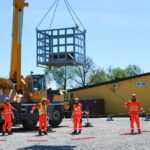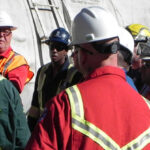
A dedicated banksman must ensure the safety of all personnel throughout the initial lifting, travel and final lowering of the load.
The banksman must effectively supervise other team members, (load handlers) while they assist in controlling the load in a safe manner.
The banksman must ensure that lifting operations are completed without causing damage to the load, third party material or interference to any third party personnel.
The banksman should not be required to assist in controlling the load manually.
The person authorized and qualified to do banksman and slinging must always pay close attention to details.
One careless moment or act can result in serious injury or death and tremendous property damage.
Proper signalling should never be left to the inexperienced. If you don’t know how to do it properly, then don’t attempt it.
Requirements of a Banksman
- Competent
- Fit, with particular regard to eyesight, hearing, reflexes and mobility
- Able to judge distances, heights and clearances
- Trained in the techniques of signalling and should understand the signal code
- Capable of giving precise and clear verbal instructions where audio equipment (e.g. radio) is employed and capable of operating the equipment
- Capable of directing the safe movement of the crane and load
- Nominated to carry out signalling duties
- Aware of the responsibilities allocated by the appointed person to the crane operator and slinger.
Banksman Duties in Rigging and Lifting Operations
The role of a banksman/signaller is required in offshore and onshore lifting operations and these involve the following duties:
1. Ensure that he is easily identifiable from other personnel by wearing a hi-vis jacket or reflective vest which is clearly marked to indicate that he is an authorised banksman or signal person.
2. Ensure that both he and the crane operator are aware of all aspects of the lifting operation to be undertaken.
3. Ensure that both he and the crane operator have agreed and are familiar with the method of signalling to be used. All signalling must be conducted in a clear and concise manner.
4. Be aware of the wind speed and direction.
5. Check cargo manifests and reviewing weight of the load with the crane operator and rigger.
6. Be familiar with the capacities and parameters of the crane in use for the lifting operations.
7. Check that the lifting gears being used are in good condition, certified for use, correctly colour coded and of sufficient capacity to carry out the lift.
8. Ensure that a cargo handling pennant of appropriate length and capacity is attached to the crane hook and is suitable for the particular lift to be carried out.
9. Ensure that taglines are attached to any long or awkward loads to facilitate easier handling e.g. casing, drill pipe, completion baskets, except when backloading to supply vessels.
10. Be aware of any obstructions within the crane’s radius and working area.
11. Check that the area around the load to be lifted is clear and that the load is not attached to the deck, transportation cradle, or adjacent equipment. Ensure that taglines in use are not secured or tied off to adjacent equipment or structures.
12. Be aware of potential snagging points in the vicinity of the load whilst hoisting/lowering in restricted areas. Always check above to ensure that the crane’s hoist rope, hook block assembly and attachments have a clear passage.
13. Ensure that he identifies escape routes for all parties involved with each lifting operation, should a problem develop whilst, either lifting the load clear of the deck or setting it down in its final position.
14. If using hand signals, the Banksman shall stand in a position where the crane operator can clearly see him and he can maintain visual contact with the load, load handler(s), and potential crane boom collision points such as drilling derrick, flare tower, turbine exhausts etc.
15. When using radio communications to instruct the crane operator, the Banksman shall stand in a position where he can maintain visual contact with the load, Load Handler(s) and potential crane boom collision points such as the drilling derrick, flare tower, turbine exhausts etc.
16. Always use clear and distinct signals (either by hand or by radio) to control lifting operations. In poor light conditions, exaggerate all hand signals.
17. When lifting, stop the load just clear of the deck to check balance and security of load. This will also give the crane operator the opportunity to check the function of his hoist brake.
18. Make it clear to the crane operator where the load has to be moved to and placed. Ensure the receiving landing area has sufficient room to take the load. If possible, precede each load to its destination. Alternatively, ensure that another team are in position to receive the load.
19. Warn other personnel in the area of the movement of the load. Avoid moving the load over the heads of other personnel.
20. Keep a check on other activities within the crane’s operating area to avoid the development of unforeseen hazards.
21. When carrying out lifts, under radio communication, which are out of the line of vision of the crane operator, normally deemed “blind” lifts, ensure that the crane operator receives a full briefing of the intended lifting operation(s). Paint a verbal picture of the manoeuvres/load movement that are about to be carried out and do not proceed until he/she gives an acknowledgement of understanding.
22. During “blind” lifts the criticality of the lifting operation may be such that there is a requirement for the crane operator to acknowledge and repeat the instruction he has received over the radio. Ensure that no part of the lifting operation proceeds unless a precise acknowledgement has been received from the crane operator.
23. During “blind” lifts which are being conducted by a hand signalling method and more than one Banksman is being used to relay instructions to the crane operator, each Banksman should stand in a position where he/she can be clearly seen by the next person in the chain. All signals should be clear and precise. The Banksman at the load should have a complete overview of the activity.
24. When lifting operations are being conducted through hatches to lower decks, always barrier off the hatch area and erect signs. The barriers must not be removed until the hatch has been replaced and is secure.
25. During overhead lifting operations e.g. on the drill derrick or flare tower assemblies, the area at deck level shall be barrier off to ensure that personnel not involved in the operation do not encroach and expose themselves to the danger of potential falling objects. Appropriate signs should be posted.
26. If the crane stops, be aware it may well be that the crane operator has lost sight of the Banksman’s signals, or, if radio communication is being used, a third party has transmitted on the working channel. Re-establish visual or oral contact with the crane operator.
To ensure the competence of personnel in the planning and safe execution of lifting operations, contact us for our banksman and slinger training.
Visit our website: www.primeliftsafetyng.com. Email us at training@primeliftsafetyng.com
Call/Whatsapp us on 08037957878.










